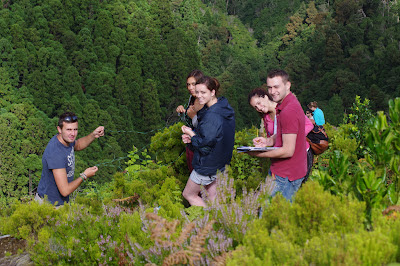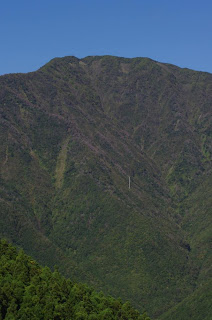Our third day on the Azores was also our longest. We were off at 8 AM
to travel all the way across the island to Serra da Tronqueira near
Nordeste. This area is the last remaining habitat for the Azores
Bullfinch, a Sao Miguel endemic. The species has suffered in the past
from loss of its Laurisilva forest habitat due to the planting of
Cryptomeria japonica as well as other factors. The world's population is a mere 1200–1500 pairs.
Cryptomeria japonica
was planted as a source of timber and forms thick, dark forests where the Bullfinch's native food plants cannot grow. A
recent project has allowed clearing of an area of
Cryptomeria
and the area has been replanted with native tree species of the Laurisilva
forest. Many of the plants of the Laurisilva forest are endemic to the
Azores (a few examples are shown below).
We have been monitoring the vegetation of this area since 2008, and today we visited for our annual Plymouth University survey to see how the trees were
growing and assess the other species present. Invasive species are a big problem in the Azores, and the team managing this area has been fighting hard to control several aggresive plants like the ginger lily,
Hedychium gardnerianum. Nevertheless, native species have also been arriving over the years, including several endemic species.
Once we had completed the survey, we visited one of the few remaining bits of mature laurisilva forest. Some of the group decided to walk most of the way home along the forest track. Although not everyone saw the endemic bullfinch, quite a few people did. We estimated that at least ten bullfinches were seen today. Not bad given the number of people and the noise!
 |
| The reforestation area with Cryptomeria in the background |
 |
| Paul helping students monitor their plots |
 |
| Surveying plots (not standing round 'onest guv) |
  |
| Who knew you could have so much fun with string and a tape measure on a mountain? |
 |
| Laurisilva forest on Pico da Vara |
 |
| Priôlo (Azores Bullfinch) |
 |
| Laurus azorica |
 |
| Juniperus brevifolia |
 |
| Vaccinium cylindraceum |
 |
| Ilex perado ssp. azorica |
 |
| Erica azorica |
 |
| Paul "Thor" Ramsay wields his mighty hammer. |
 |
| Not quite Rio... |
 |
| One of the survey teams, possibly the most thorough... or maybe the slowest. |




































